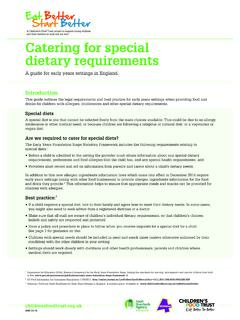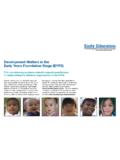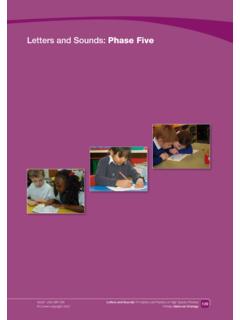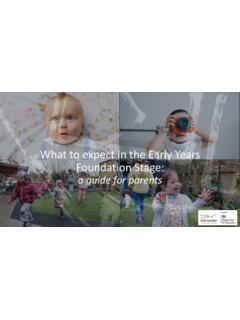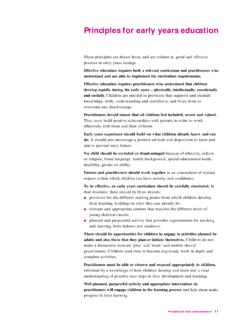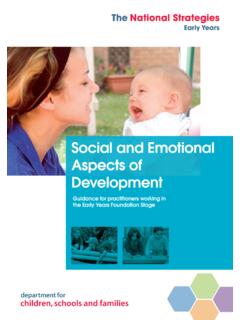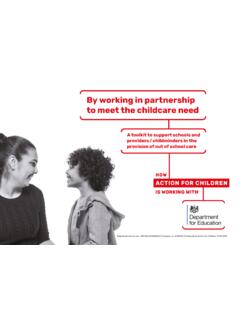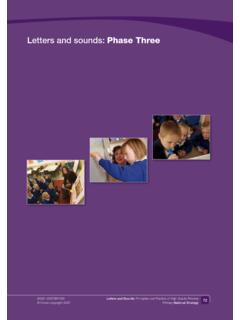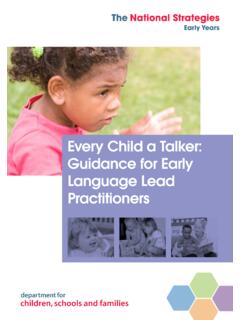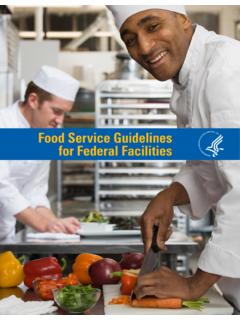Transcription of Eat better, start better - Foundation Years
1 Voluntary food and drink guidelines for Early Years settings in practical guideEat better , start better It was developed following the recommendations of the Advisory Panel for food and Nutrition in Early Years , and was produced to support early Years settings in England to meet the nutritional requirements of children in their care, and encourage them to eat for Children would like to thank the Children s food Trust and the members of the External Reference Group involved in the development of this practical guide. The sharing of their experience, expertise and providing their recipes provides an invaluable resource to all Early Years providers to give children the foundations for a healthy of children by Karla Gowlett, with thanks to Katharine Bruce Community Nursery, part of the London Early Years Foundation .
2 Additional photos of children with thanks to NCMA (now PACEY ), NDNA and Pre-school Learning Alliance. Meals and snacks prepared and photographed by Helena Little (Brave Design) and Erica Hocking. Additional photos with kind permission from the Caroline Walker practical guide to the Voluntary food and Drink Guidelines for Early Years Settings in England was first published in January 2012 and updated 4 Section 01 Why healthy eating matters for young children 5 Why has this guide been developed? 6 Who is this guide for? 6 Why is a healthy, balanced and nutritious diet essential 7 for young children?What is the current health status of young children in England?
3 7 What is a healthy, balanced, nutritious diet for children 7 aged one to four Years ?How does a healthy, balanced diet for children aged one to 8 four Years differ from that needed by older children and adults?What about food and drink for children from birth up to 8 12 months old?Breastfeeding 8 Vitamin supplements and the Healthy start scheme 9 Nursery Milk Scheme 9 Physical activity 9 Section 02 Planning menus 10 Seven steps for planning healthy meals, snacks and drinks 11 Section 03 The food and drink guidelines 12 Understanding the food and drink guidelines 14 How to use portion size information 14 Summary of the four food groups 15 Guidelines for potatoes, bread, rice, pasta and other 16 starchy carbohydratesGuidelines for fruit and vegetables 18 Guidelines for beans, pulses, fish, eggs, meat and other proteins 20 Guidelines for dairy and alternatives 22 Guidelines for desserts.
4 Puddings and cakes 24 Guidelines for drinks 26 Guidelines for fat 27 Guidelines for salt 28 Guidelines for sugar 29 How to read food labels 30 Iron and zinc 31 food additives 32 Ready-made meals and take-aways 32 Fortified foods 33 Section 04 At a glance: food and drink guidelines for each meal and snack 34 Balancing lunch and tea 35 Breakfast at a glance 36 Mid-morning and mid-afternoon snacks at a glance 38 Lunch at a glance 40 Tea at a glance 42 Section 05 How to encourage children to eat well 44 Developing a food policy and putting it into practice 45 Communicating with children and families 45 The eating environment and social aspects of meal times 46 Celebrations and special occasions 47 Providing food for all 48 Encouraging fussy eaters to eat well 51 food brought in from home 52 Learning about and through food 53 Cooking with children 54 food safety and hygiene 55 Sustainability
5 55 Protecting children s health maintaining a healthy weight 55 Providing food for infants aged six to 12 months 56 Section 06 Practical tools and resources: putting the guidelines into practice 60 Evaluating and showing others your approach to 61 food and drink provisionEarly Years Code of Practice for food and Drink 62 Code of Practice Checklist 63 Menu Planning Checklist 65 The nutrient framework 70 Example spring/summer menu, one to four year olds 73 Example autumn/winter menu, one to four year olds 74 Example spring/summer menu, infants seven to 12 months 75 Example autumn/winter menu, infants seven to 12 months 76 Sizes of plates and bowls 77 Glossary 79 Section 07 Where to find additional information 82 References 84 Contents3 Eat better , start better A practical guideThe under-fives are a unique age group in that their nutritional needs change quite rapidly, and guidance regarding food groups and portion sizes is a particular area of need.
6 Nurseries are passionate about helping children get the best start in life, and this guidance will help them do this consistently throughout their day-to-day Schofield, Director of Membership, Policy and Communications, National Day Nurseries Association (NDNA) We are passionate about reducing inequalities in childhood. The national food and drink guidelines will help to ensure that all young children have access to a healthy, balanced, nutritious diet while attending early Years Connor, Assistant Director Practice and Programmes (Early Years ), National Children s BureauAction for Children supports parents, carers and anyone working with children by giving them the tools and guidance they need to ensure that every child has the very best start in life.
7 We are seeing too many young children start school overweight which leads to long-term problems. This can be avoided with your help, and by using this practical guide developed by the Children s food Trust which is an essential resource for early Years practitioners. Children need to acquire good food habits early on that lay the foundations for a healthy future and this guide shows Hawkhead, Chief Executive, Action for ChildrenWe were delighted that so many of our members contributed some great practical tips and tools to help children eat healthily. We very much welcome these updated guidelines which will help ensure that all children have access to the healthy, balanced diet they need to give them the best start in Bayram, Chief Executive, Professional Association for Childcare and Early YearsThe update of the Children s food Trust Voluntary food and Drink Guidelines for Early Years Settings in England.
8 A Practical Guide supports the updated Government advice in HM Government Menus and Guidance for early Years settings, providing helpful advice on how to ensure food provision meets the nutritional needs of young Alison Tedstone, Chief Nutritionist, Public Health EnglandEat better , start better was supported with a grant under the Department for Education s improving Outcomes for Children, Young People and Families welcome this updated guide and the opportunities it provides for helping children eat healthy and nutritious food . It is vital that we set a good Foundation for the health and wellbeing of all our children. Ruth Pimentel, Director of Nurseries, Action for ChildrenHigh quality early education boosts children s learning and can help to narrow the gap between disadvantaged children and their peers.
9 Providing healthy food sets children up to learn and enjoy, which is why we support these guidelines and their role in improving the quality of food provided by nurseries and childminders. Ellen Broom , Chief Executive, Family and Childcare children attending early Years settings should benefit from a healthy, balanced and nutritious diet, and these voluntary guidelines are an excellent resource to help to build practitioners knowledge, skills and confidence when cooking or preparing food . With both the EYFS and Ofsted s Common Inspection Framework placing a strong focus on children s nutrition, following these guidelines will help settings meet national standards and demonstrate to parents a strong commitment to helping children eat Leitch, Chief Executive, Pre-school Learning AllianceWith special mention to the Children s food Trust for the development of this PageWhy has this guide been developed?
10 6 Who is this guide for? 6 Why is a healthy, balanced and nutritious diet essential for young children? 7 What is the current health status of young children in England? 7 What is a healthy, balanced, nutritious diet for children aged one to four Years ? 7 How does a healthy, balanced diet for children aged one to four Years differ from that needed by older children and adults? 8 What about food and drink for children from birth up to 12 months old? 8 Breastfeeding 8 Vitamin supplements and the Healthy start scheme 9 Nursery Milk Scheme 9 Physical activity 9 Why healthy eating matters for young children015 Eat better , start better A practical guideEarly Years settings provide an ideal opportunity to help every child eat well, enjoy a varied diet and establish healthy eating habits to take with them into their school guide sets out the food and drink guidelines for early Years settings in England.
